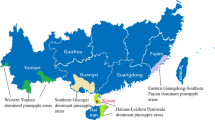Abstract
Morphological, phenological and fruit quality traits of 55 apricot cultivars, including the most important clones grown in Spain, France and Italy, were evaluated using principal component analysis. Given that the studied material was made up of commercial cultivars, the range of variation observed was narrower than expected. Variation was observed for traits related to phenology and fruit quality. The only correlation observed between morphology and phenology was that of blossom and budbreak season being correlated with internode length. Harvest season was negatively correlated with acidity and not correlated with total soluble solids (TSS). Native cultivars from Spain and Tunisia are a good source of early ripening but they lack fruit size and postharvest handling qualities, respectively. The most appreciated fruit quality characteristics were present in several cultivars.
Similar content being viewed by others
References
Audergon, J.M., 1993. Variety and Breeding. Xth International Symposium on apricot culture. Izmir (Turkey). Acta Horticulturae 384, 35-45.
Badenes, M.L., M.J. Asins, E.A. Carbonell & G. Llácer, 1996. Genetic diversity in apricot (Prunus armeniacaL.) aimed at improving resistance to plum pox virus. Plant Breeding 115: 133-139.
Badenes, M.L., G. Llácer, M.J. Asins, J. Guerri & S. García, 1993. Caracterización de variedades y clones de albaricoquero. Investigaci ón agraria. Prod Prot Veg 8 (1): 55-65.
Badenes, M.L., J. Martínez-Calvo, S. García Carbonell, D. Villarrubia & G. Llácer, 1997a. Descripción de variedades de albaricoquero autóctonas de la Comunidad Valenciana. Publicaciones de la Consellería de Agricultura de Valencia. Serie Técnica. 62 pp ISBN: 8448216032.
Badenes, M.L., J. Martínez-Calvo & G. Llácer, 1997b. Estudio comparativo de la calidad de los frutos de 26 cultivares de melocotonero de origen norteamericano y dos variedades población de origen espãnol. Investigación Agraria. in press.
Bassi, D., E. Bellini, R. Guerriero, F. Monastra & F. Pennone, 1993. Apricot breeding in Italy. Xth International Symposium on apricot culture. Izmir (Turkey). Acta Horticulturae 384, 47-54.
Brooks, R.M. & H.P. Olmo, 1972. Register of new fruits and nut varieties. 2nd ed. Univ. of California Press, Berkeley, California.
Byrne, D.H. & T.G. Littleton, 1989. Characterization of isozyme variability in apricots. J Amer Soc Hort Sci 114: 674-678.
Byrne, D.H., A.N. Nikolic & E.E. Burns, 1991. Variability in sugars, acids, firmness, and color characteristics of 12 peach genotypes. J Amer Soc Hort Sci 116: 1004-1006.
Cemagref, 1981. La qualité gustative des fruits.Méthodes practiques d'analyse. Ministry of Agriculture. France. 150 pp.
Couranjou, J., 1977. Variétés d'abricotier. Inst. National de vulgarization pour les fruits, legumes et champignons. Paris.
Della Strada, G. Pennone, F. Fideghelli, F. Monastra & D. Cobianchi, 1989. Monografia di cultivar di albicocco. Istituto Sperimentale per la Frutticoltura, Rome. 239 pp.
Hilling, K.W. & A. Iezzoni, 1988. Multivariate analysis in a sour cherry germplasm collection. J Amer Soc Hort Sci 113: 928-934.
Iezzoni, A.F. & M.P. Pritts, 1991. Applications of principal component analysis to horticultural research. Hort Science 26: 334-338.
Karayiannis, I., A. Mainou, G.D. Syrgianidis & D.C. Stylianidis, 1991. Apricot cultivars detected in Greece as having types of resistance to Plum Pox virus and used as genitors in crossing. 2ême rencontre du groupe abricotier, Avignon. Mai 1991, 7.
Kostina, K.F., 1969. The use of varietal resources of apricots for breeding. Trud Nikit Bot Sad 40: 45-63.
MAPA, 1993. Anuario de Estadística Agraria. Ministerio de agricultura y alimentación: 322-323.
Martin, G.B. & M.N. Adams, 1987a. Landraces of Phaseolus vulgaris(fabaceae) in northem Malawi. I regional variation. Econ Bot 41: 190-203.
Martin, G.B. & M.N. Adams, 1987b. Landraces of Phaseolus vulgaris(fabaceae) in northem Malawi. II Generation and maintanance of variability. Econ Bot 41: 204-215.
Pérez-González, S., 1992. Association among morphological and phenological characters representing apricot germplasm in central Mexico. J Amer Soc Hort Sci 117(3): 486-490.
Pérez-González, S., S. Montes & C. Mejía, 1993. Analysis of peach germplasm in Mexico. J Amer Soc Hort Sci 118(4): 519-524.
Syrgianidis, G. & A.C. Mainou, 1991. Deux nouvelles variétés d'abricotier résistantes á la maladie á virus de la sharka (Plum Pox virus), issues de croisements. 2ème rencontre du groupe abricotier, Avignon, Mai 1991, 6.
Author information
Authors and Affiliations
Rights and permissions
About this article
Cite this article
Badenes, M., Martínez-Calvo, J. & Llácer, G. Analysis of apricot germplasm from the European ecogeographical group. Euphytica 102, 93–99 (1998). https://doi.org/10.1023/A:1018332312570
Issue Date:
DOI: https://doi.org/10.1023/A:1018332312570




